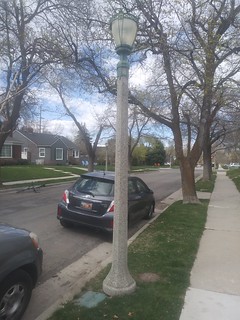Concrete neighborhood streetlight pole

I've mentioned that Salt Lake City has what seems to be a unique program that allows residents on a street or in a larger neighborhood to band together and install a "private" network of sidewalk focused streetlights. The city will provide grants to help this along. But the project is organized and coordinated by residents.
It's also a lot cheaper because instead of linking the streetlights to the grid separately--usually through an underground network of cabling that requires digging up a portion of the entire street--the streetlights are connected to the grid via the electricity connection to individual houses--and that property pays for the cost of the electricity.
But I haven't seen many examples of concrete streetlight poles, which are super long lasting. (San Francisco should use this material as it is impervious to urine for much longer period. See "Lamp post destroyed by urine falls in street, just misses driver," San Francisco Chronicle.)
However, it's possible that these streetlights were installed by the original developer of the neighborhood, as the style is in keeping with other street furniture elements, like signage, placed elsewhere.
Labels: electric utility infrastructure, neighborhood planning, street furniture, urban design/placemaking



0 Comments:
Post a Comment
<< Home